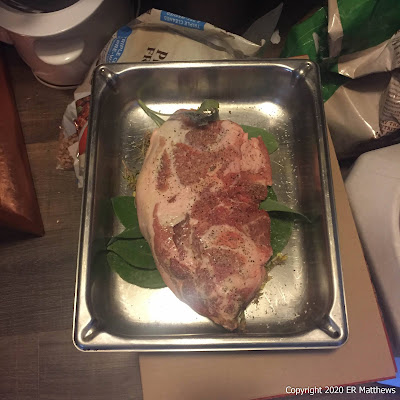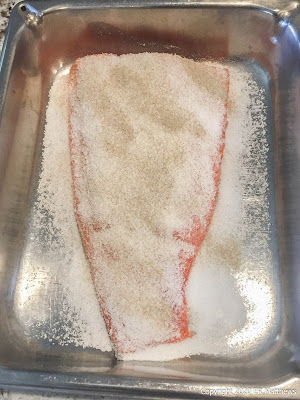One of the glories of Mexican cuisine is rajas con crema, strips of roasted green chile in cream. It doesn't sound like a whole lot, but this is one of those dishes that is way more than the sum of its parts. It's really too bad that you'd be hard pressed to find a restaurant with this classic dish from central and southern Mexico on the menu. But cry not, it's a simple dish to make.
 |
Tacos de Rajas con Crema y Elote
|
Recently I had an overload of poblano peppers in the refrigerator that I wanted to use before they started going bad, so I thought to make rajas con crema y elote for Ann. I knew she would love it and I was certain she had never had this dish before.
Although you can make rajas out of any large green chile, pretty much everyone uses the large, deep green, and mildly spicy poblano, the same chile that most people stuff for chiles rellenos.
Aside from small, spicy peppers such as jalapeños or serranos, poblanos are the only green pepper in my refrigerator. My palate dislikes cooked green (unripe) bell peppers. Like a lot of people, I find that they repeat on me and the second visit is most unwelcome. I have no such issue with poblanos. Never once in 15 years did we ever have a green bell pepper in my restaurant, while we used a half a bushel of poblanos a week at a minimum.
Unlike when I first started cooking, poblanos are now in most grocery stores. Do be aware that they may be labelled pasilla peppers. For some reason, the American produce trade frequently labels poblanos as pasillas. To get poblanos at the restaurant, I had to order pasillas. The other day at our grocery store, a new clerk had to look up the code for the poblano peppers in my cart. I helped her scan the list of peppers on her terminal. We finally found a picture of them labelled pasillas.
For the record, though not many people care, we are confusing two peppers, the poblano, a large deep green, broad and strongly triangular chile, and the chilaca, a very long skinny, often twisted, also very dark pepper that tapers on both ends much like a serrano. When dried, we call a poblano an ancho. Likewise, the chilaca becomes the pasilla. So, besides being different peppers, a poblano is a fresh chile while a pasilla is a chile seco, a dried chile.
Preparing Rajas
Rajas translate into English as strips, strips of chiles being implied. The first step in preparing them is to peel the poblanos. After peeling, then you can cut them into strips. To remove the tough skins, you have to char the chiles to the point where the skin will detach.
 |
Charring the Skin with a Torch
|
There are many ways to do this. At the restaurant, we would line our grill with poblanos and as each side would char and blister, we'd give the chiles a turn. Because of the triangular shape, poblanos generally have three sides. If you have good ventilation, you can char them right in the flame of your range top. Or, you can run them under the broiler in your oven or in a restaurant, under the flame of the salamander.
At home, because I have the world's most useless broiler and even crappier ventilation, I prefer to char mine outside. I could do this on the propane grill, but I prefer my propane torch. If you've ever seen how they roast Hatch chiles in big metal lattice drums rotating over propane flames, you have seen my inspiration.
Here's a shameless plug for my Bernzomatic TS8000 torch head. Although expensive, these torch heads get the job done. I wasted a lot of money on cheaper heads over the years. We used TS8000s constantly at the restaurant for scores of tasks from popping the air bubbles on top of a custard to lighting charcoal to adding a little color to a dish to caramelizing sugar on everything from split figs to crème brûlée.
Any way you choose to do it, after you char the skin, a pepper will appear similar to the photo just below.
 |
A Poblano Charred All Over
|
After charring each pepper, place it into a plastic bag, where the trapped steam will help the skin to separate from the flesh of the pepper.
 |
Charred Poblanos Steaming in a Plastic Bag
|
After about 20 minutes, the chiles will have steamed enough and cooled enough to handle to peel. You might think about gloving up to peel the chiles. I have run across some wickedly spicy poblanos that left painful chemical burns on my hands. This is really rare, but... consider yourself forewarned. Also, if you get capsaicinoids on your bare hands, it's easy to inadvertently burn your eyes, face, or your privates. Enough said. Just trust me on this lesson learned.
 |
Peeled Poblanos Ready to Process Further
|
After peeling the poblanos, you are ready to process them further. For rajas, I slice the top off, slit one side, and remove all the seeds. If I am making rellenos, I cut a T in the side (from bottom to top and across the shoulders), open the flaps, and pull out the seeds, leaving the top and stem intact. For rajas, once I have flattened the chiles, I stack them and cut them into strips lengthwise.
As you can see, using a torch leaves the poblanos almost raw which is perfect for stuffing. If you char them by other means, the flesh is going to be a lot softer, prone to ripping, and a lot slipperier when trying to stuff them. For rajas as in this case, you are going to want to cook the pepper strips a bit further to soften them up and to lose the raw flavor. You can see in the photo below how raw my rajas look.
 |
Rajas
|
Making Rajas con Crema
Once you have your rajas, you are ready to make your creamed poblanos. I'm not going to give an exact recipe here because I used a somewhat unorthodox method. A lot of fat doesn't sit well in my stomach, so I went with a much lower fat method than is traditional. Also, many recipes call for a bit of onion in with the peppers; I deviated because I prefer garlic instead.
 |
Shaving Corn off the Cob
|
Many people shave fresh corn (elote) into their rajas and if I have fresh corn, I do too. The sweetness of the corn and the earthy spiciness of the poblanos are perfect foils for one another. After you have shaved the corn off the cob with a knife, flip the knife around and run the spine of the blade down the cobs to extract as much of the milky juice as possible. That juice contains a lot of corn starch and will help thicken your sauce.
Although there are as many methods to make the dish as there are cooks, it is traditionally made with cream (crema) and white cheese, the kind of cheese varying from cook to cook. To reduce the fat, I make a thick béchamel using 2 percent milk and omit the cheese.
Because my rajas were nearly raw, I needed to soften them further by putting them in a skillet with a tablespoon or two of oil and a cup or so of chicken stock. For a vegetarian dish, water would have worked just as effectively. As the chicken stock boiled, it steamed the rajas to tender in about seven or eight minutes.
Once all the chicken stock evaporated and I could hear the rajas crackling in the oil, I added a couple of garlic cloves, finely minced, and the shaved corn. I let that cook for a minute, just long enough for the garlic smell to go from raw to cooked. At this point I sprinkled a couple tablespoons of flour over, stirred it in, and let it cook another couple of minutes to remove any raw flour flavor, without browning the flour at all.
After that I added a cup or two of 2 percent milk, salt, and pepper, making a béchamel. Once the béchamel cooked down very tight, I took the pan off the flame, stirred in a spoonful of sour cream and served the rajas on tortillas with queso Cotija and cilantro, as you see in the lead photo of this article.
Traditionally, you cook the crema down tight and swirl the cheese in to yield a very rich dish that is firm enough to put on tortillas. That amount of fat doesn't work for me, while the béchamel method makes me very happy. ¡Buen provecho!




















































